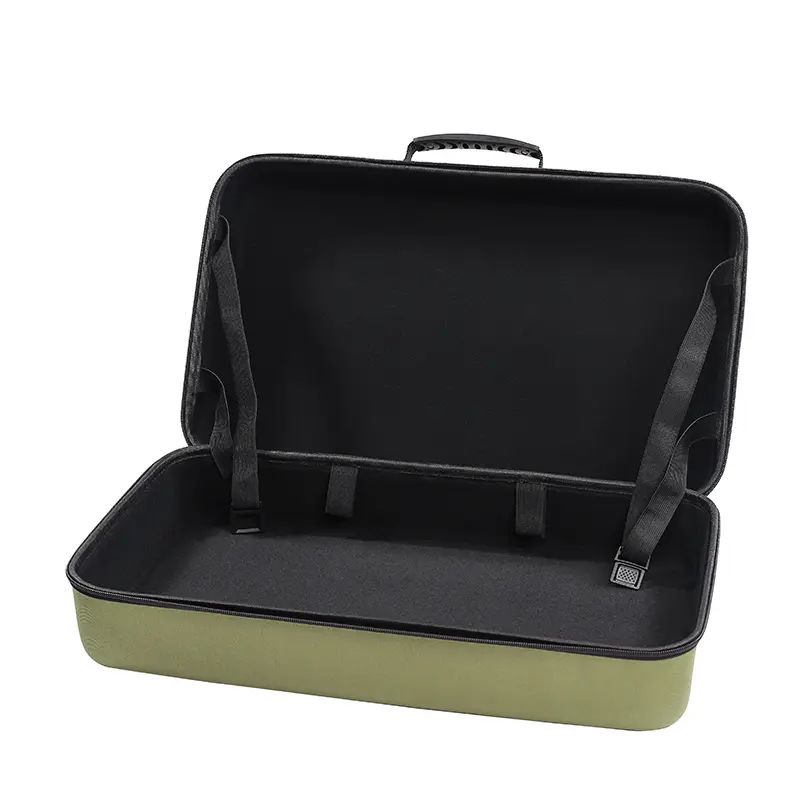Technical Details of the Waterproofing Process for EVA Tool Bags
In the tool storage industry, waterproofing is no longer an optional feature; it’s a core requirement for ensuring tool safety and extending tool life. Whether it’s sudden rainfall during outdoor work, oil spills in the workshop, or water stains accidentally encountered during daily use, once it seeps into the tool bag, it can cause rust and short circuits, or even damage delicate instruments, resulting in irreparable damage. As a brand specializing in high-quality tool storage solutions, our EVA tool bags incorporate a comprehensive waterproofing system, from material selection to production process. Today, we’ll delve into the technical details and explore how we use our expert craftsmanship to safeguard every tool.
I. The Foundation of Waterproofing: The Natural Waterproofing Properties and Modifications of EVA Substrate
EVA (ethylene-vinyl acetate copolymer) inherently possesses certain water-repellent properties. Its compact molecular structure makes it difficult for water molecules to naturally penetrate the substrate, laying the foundation for the waterproofing of tool bags. However, to address more complex use cases, we went beyond the base material’s native performance and further enhanced its waterproofing capabilities through base material modification technology.
1. High-Density EVA Base Material
The EVA base material we selected boasts a density exceeding 0.95g/cm³ (compared to the typical industry base material density of 0.85-0.9g/cm³). This higher density results in smaller inter-molecular gaps, which not only prevents water penetration but also enhances the base material’s resistance to oil, dirt, and chemical corrosion. During the production process, precise control of extrusion temperature (160-180°C) and pressure ensures a bubble- and pinhole-free base material after molding, thus preventing potential waterproofing risks caused by base material imperfections.
2. Waterproof Coating Lamination Process
To further enhance the surface waterproofing, we applied a food-grade TPU waterproof coating (0.12-0.15mm thick) to the outer surface of the EVA base material. TPU (thermoplastic polyurethane) material not only offers excellent waterproof properties but also boasts exceptional abrasion and aging resistance, effectively protecting tool kits from the effects of UV rays, high temperature, and high humidity.
The coating is laminated using a hot-melt adhesive process. Through precise control of temperature (120-140°C) and pressure, the TPU coating adheres tightly to the EVA substrate, preventing delamination and bubbles, forming a complete waterproof barrier. Furthermore, the hot-melt adhesive is made from environmentally friendly polyurethane, offering both high bond strength and a certain degree of elasticity to accommodate the bending and folding of the tool kit during use, preventing the coating from cracking due to deformation.
II, the key to waterproofing: Sealing seams and openings
Even if the substrate itself is inherently waterproof, improperly treated seams and openings can still become weak links in waterproofing. We employ customized sealing processes for different structural areas of the EVA tool kit to ensure seamless waterproofing.
1. One-piece Molding: Minimizing Seams and Enabling Waterproofing
For the main components of the tool bag (such as the case and storage compartments), we utilize an EVA one-piece molding process. Through mold foaming and hot pressing, the main components are seamless, eliminating leaks caused by poorly sealed seams. This one-piece molding process not only enhances waterproofing but also strengthens the tool bag’s structural strength, allowing it to withstand greater impact and better protect the tools within.
During the one-piece molding process, we precisely control the foaming temperature (180-200°C), foaming time (5-8 minutes), and pressure to ensure uniform and fine EVA pores, free of voids and cracks, further enhancing the base material’s waterproofing properties. Furthermore, the finished product undergoes a fine polishing process to remove burrs and imperfections, laying a solid foundation for subsequent coating lamination.
2. High-Frequency Heat Sealing: Seam-Tight, Leak-Proof
For joints on the tool kit, such as the lid and side pockets, we use high-frequency heat sealing. High-frequency heat sealing utilizes a high-frequency electromagnetic field to induce intense vibrations in the EVA matrix molecules, generating heat through friction. This process melts and fuses the contacting surfaces together, creating a strong, airtight seam.
Compared to traditional needle and thread sewing, high-frequency heat sealing eliminates the need for perforations, preventing them from becoming leak paths. Furthermore, the seams exhibit higher bond strength, withstand greater tensile forces (seam peel strength ≥ 5N/cm), and exhibit excellent elasticity, resisting cracking even after repeated folding. During the heat sealing process, we precisely control the high-frequency power (15-20kHz), sealing time (2-3 seconds), and pressure to ensure thorough and uniform melting and fusion of the seams, eliminating any weld defects or gaps, resulting in a leak-proof seal.
3. Waterproof Zippers and Sealing Strips: Opening Protection, Double Protection
The tool bag’s openings (such as the main zipper and side pocket zippers) are critical to waterproofing. We employ a dual-protection solution: a waterproof zipper + sealing strips.
Waterproof Zippers: We use professional, outdoor-grade waterproof zippers. The zipper teeth are made of nylon and coated with a waterproof coating (typically PTFE) to effectively block water penetration. The zipper tape is made of waterproof Oxford cloth and treated with a PU coating to further enhance its waterproofness. Furthermore, the zipper pull is equipped with a waterproof rubber ring. When the zipper is closed, the rubber ring fits tightly against the zipper tape, forming a seal that prevents rain from seeping in through the zipper gap.
Sealing Strips: We’ve installed a silicone sealing strip at the interface between the tool bag’s lid and the main body. The sealing strip is made of highly elastic silicone, offering excellent waterproofing, abrasion resistance, and aging resistance, suitable for use in various temperature environments (-30°C to 80°C). The strip is secured with a snap-on design, ensuring a tight fit within the tool bag. When the lid is closed, the strip is compressed, creating a tight seal that effectively prevents rain, dust, and other impurities from entering the tool bag.
In addition, to ensure precise installation of the sealing strip, we have designed precise slots in the tool bag body (with a slot width tolerance of ≤0.1mm) and use automated equipment to ensure a tight fit, without gaps or misalignment.
III. Waterproofing Verification: Rigorous Performance Testing Ensures Quality
To ensure that every EVA tool bag possesses excellent waterproofing properties, we have established a rigorous waterproofing testing system. This comprehensive, multi-step testing process, from raw materials to finished product, ensures that our products meet or exceed industry standards.
1. Raw Material Waterproofing Testing
Before raw materials enter storage, we conduct waterproofing tests on key materials, including EVA substrates, TPU coatings, hot-melt adhesives, and sealants.
EVA substrate waterproofing testing: An immersion test is used. Submerge substrate samples in room-temperature, clean water (50mm depth). After 24 hours, remove the sample and inspect for water absorption (weight gain ≤ 1% is acceptable).
TPU coating waterproofing testing: A spray test is used. Water at a pressure of 0.3MPa (23±2°C) is sprayed onto the coating surface at a 45° angle for 30 minutes. The coating is then inspected for water seepage (no moisture on the substrate is acceptable).
Sealing strip waterproofing testing: A compression seal test is used. The strip is compressed to 50% of its original thickness and placed in room-temperature, clean water (100mm depth). After 24 hours, remove the sample and inspect for water absorption and expansion (volume change ≤ 5% is acceptable).
2. Finished Product Waterproofing Testing
Before shipping, each batch of EVA tool kits undergoes a sampling test for water resistance. Testing includes the following:
Whole Water Immersion Test: Completely immerse the finished tool kit (with absorbent paper inside) in room-temperature water (300mm depth). After 30 minutes, remove the kit, open it, and inspect the absorbent paper to see if it is moist (a pass is considered acceptable if no moisture is present).
Spray Test: In accordance with GB/T 4744-2013, “Textiles—Determination of Waterproofness—Hydrostatic Pressure Method,” spray the tool kit with clean water at a pressure of 0.5 MPa (water temperature 23±2°C) at a 30° angle for 60 minutes. Afterward, inspect the interior for water infiltration (a pass is considered acceptable if no water seepage is present). Heavy Rainfall Simulation Test: The tool bag is placed on a 30° tilted test bench in a simulated heavy rain environment (rainfall ≥ 100mm/h, wind speed ≥ 10m/s) for 2 hours. The tools inside are then inspected for moisture (no moisture or rust on the tool surface is considered acceptable).
Only products that pass all testing criteria are released for sale, ensuring that every EVA tool bag is reliably waterproof.
IV. Waterproof Applications: Adaptable to Multiple Scenarios, Protecting Tool Safety
Our EVA tool bags, with their superior waterproofing, are widely applicable across multiple industries, providing comprehensive waterproof protection for various tools:
Outdoor work applications, such as electrical maintenance, landscaping, and geological exploration, effectively protect against sudden rain, dew, and muddy conditions, ensuring that electrical tools, gardening tools, and exploration equipment remain moisture-proof and protected from damage. In workshop production scenarios, such as automotive repair, electronics manufacturing, and machining, tool bags protect against oil, coolant, and water stains, protecting the precision and lifespan of tools like wrenches, screwdrivers, and electronic testing instruments. In everyday use, such as storing household tools and carrying outdoor camping gear, tool bags protect against unexpected situations like rain splashes and spilled water bottles, ensuring tools are clean, dry, and ready for use at all times.
Conclusion: Protecting Trust with Professional Craftsmanship
Improving waterproof performance is never a matter of simply applying a single technology; it involves comprehensive optimization, from material selection and process design to testing and verification. We firmly believe that only by meticulously focusing on every technical detail can we create an EVA tool bag that truly meets user needs.
Post time: Sep-29-2025





